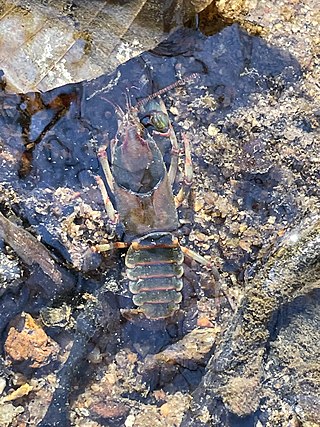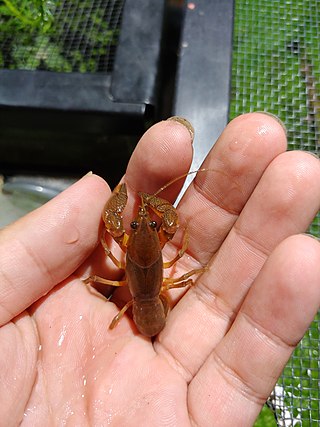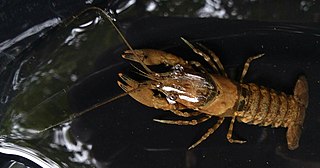
The Parastacidae are the family of freshwater crayfish found in the Southern Hemisphere. The family is a classic Gondwana-distributed taxon, with extant members in South America, Madagascar, Australia, New Zealand, and New Guinea, and extinct taxa also in Antarctica.

The Tasmanian giant freshwater crayfish, also called Tasmanian giant freshwater lobster, is the largest freshwater invertebrate and the largest freshwater crayfish species in the world. The species is only found in the rivers below 400 metres (1,300 ft) above sea level in northern Tasmania, an island-state of Australia. It is listed as an endangered species on the IUCN Red List due to overfishing and habitat degradation, and it has been prohibited to catch the crayfish since 1998.

Euastacus is a genus of freshwater crayfish known as "spiny crayfish". They are found in the south-east of the Australian mainland, along with another genus of crayfish, Cherax. Both genera are members of the family Parastacidae, a family of freshwater crayfish restricted to the Southern Hemisphere.

Leucopatus is a genus of velvet worm in the family Peripatopsidae, containing a single species, the blind velvet worm. It is found in northeast Tasmania, Australia, and is ovoviviparous.

Astacoides is a genus of freshwater crayfish endemic to Madagascar. The first specimens were brought to Europe in 1839, and seven species are now recognised, most of which are considered as threatened on the IUCN Red List. They are large and slow-growing, and are threatened by habitat loss, overexploitation by local people and by spread of introduced non-indigenous marbled crayfish. They are only found in a relatively small part of the island, mostly in undisturbed upland areas. They belong to the Gondwana-distributed family Parastacidae, but their nearest relatives live in Australasia, there being no native crayfish in mainland Africa or India.
Cambarus chaugaensis, the Chauga crayfish or Chauga River crayfish, is a species of crayfish in the family Cambaridae. It is endemic to the Carolinas in the United States of America. The common and scientific names refer to the Chauga River of South Carolina, where the first specimens were collected.
Cambarus coosawattae, the Coosawattae crayfish, is a species of crayfish in the family Cambaridae. It is endemic to Georgia. The common name refers to the Coosawattee River, with the original specimens being collected in the Cartecay River which combines with another river to form the Coosawattee.

Cambarus howardi, the Chattahoochee crayfish, is a species of crayfish in the family Cambaridae. It is found in North America. The common name refers to the Chattahoochee River, where the first specimens were collected.

Lacunicambarus miltus, the rusty gravedigger, is a species of crayfish in the family Cambaridae. It is found in the southeastern United States.

Cambarus scotti, the Chattooga River crayfish, is a species of crayfish in the family Cambaridae. It is endemic to Alabama and Georgia. The common name refers to the Chattooga River. The original specimens were collected from Clarks Creek in Chattooga County.
Cambarus williami, the Brawleys Fork crayfish, is a species of crayfish in the family Cambaridae. It is endemic to Tennessee.
Cherax nucifraga is a species of crayfish in the family Parastacidae. It is known only from the type locality – Palm Springs, near Channel Point, Northern Territory, Australia – where the holotype was collected from the stomach of a barramundi. It is listed as data deficient on the IUCN Red List.
Euastacus crassus is a species of southern crayfish in the family Parastacidae. It is commonly known as the Alpine spiny crayfish.
Charles Gould was the first Geological Surveyor of Tasmania 1859–69.

Lacunicambarus acanthura, the thornytail crayfish, is a species of crayfish in the family Cambaridae. It is found in the southeastern United States.

Euastacus spinifer is a species of freshwater crayfish endemic to Australia that belongs to the family Parastacidae.
Virilastacus is a genus of freshwater burrowing crayfish species endemic to Chile. It has four described species. The first species was described in 1914, but since 2005, three other species have been added to this genus.

Ellen Clark (1915–1988) was an Australian carcinologist and naturalist, whose work focused on crustaceans and ants Clark studied, named, described and published many of the Australian freshwater crayfish species. By 1939, she was reported to have identified more than half the known species of Australian crayfish. She conducted research about blood groups in crustaceans and made a significant contribution to the study of crayfish genera. She was the first woman to publish in the Memoirs of the National Museum of Victoria.

Faxonius erichsonianus is a species in the family Cambaridae ("crayfishes"), in the order Decapoda. A common name for Faxonius erichsonianus is reticulate crayfish. Faxonius erichsonianus is found in the south eastern United States of America.

Samastacus is a genus of southern crayfish in the family Parastacidae. It has a single species, Samastacus spinifrons.













